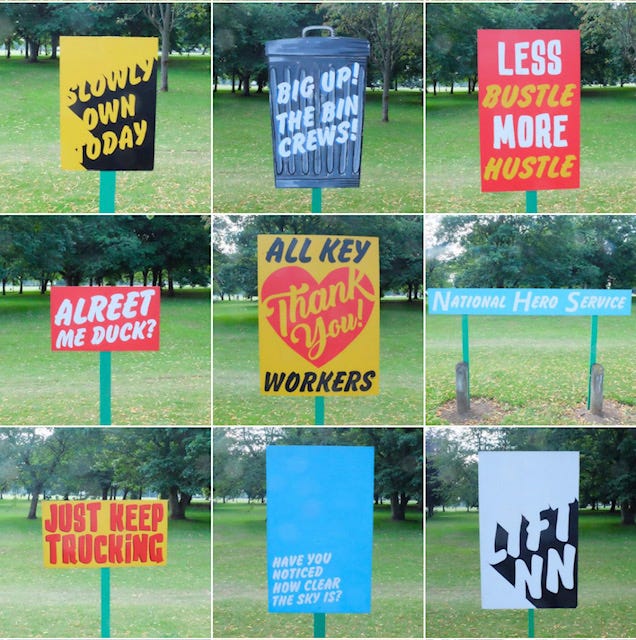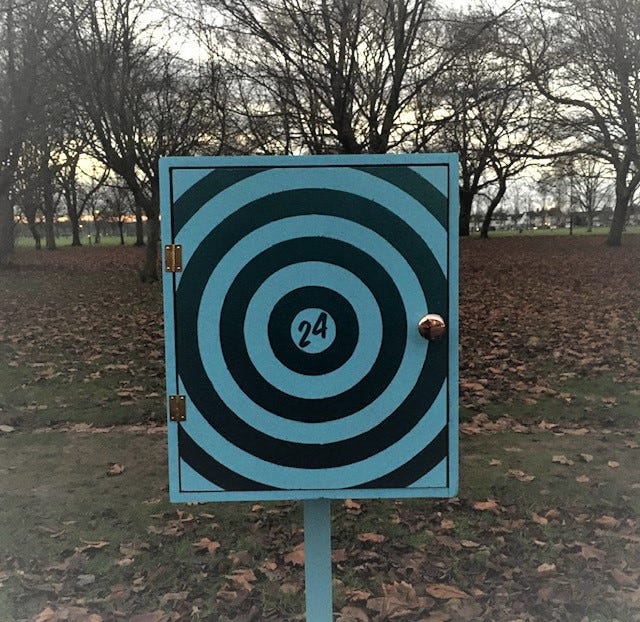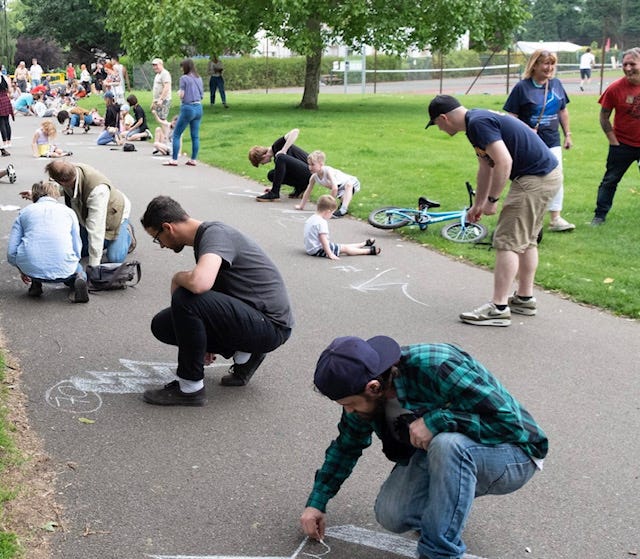‘Art shouldn’t be exclusive’
An interview with well-known Northampton artist Bill Pollard
We publish a news article each day. To have it sent straight to your inbox sign up here
By Natalie Bloomer
Bill Pollard’s style of signwriting is instantly recognisable. If you live in Northampton or visit the town regularly you are bound to have seen some of his work.
From the pink welcome sign which he painted on hoardings near the train station, to the seasonal ‘goodwill’ message on Bridge Street or logos created for many of the town’s independent businesses, Pollard’s work has become more and more sought after in recent years.
It was a series of signs he created during the first lockdown which has perhaps had the biggest impact though. One by one they appeared in a line alongside the edge of the Racecourse, bold in colour, each with a different message or expression of feeling about the pandemic.
They not only became a talking point for passersby but something people would go out of their way to go and see while on their daily walk or bike ride. Adults and children loved their fun style, an image of Boris Johnson with moveable eyes was a particular favourite with younger people as was a blackboard which people could write their own messages on.
But they were emotive too. At a time when people were clapping for the NHS on their doorsteps, Pollard’s ‘National Hero Service’ and ‘Thank You All Key Workers’ signs captured the mood of the moment.
Pollard says the idea for the signs was inspired by children putting pictures of rainbows in their windows.
“I saw all the rainbows and thought they were brilliant. I just started thinking ‘I’m a sign writer, I’ve got a park in front of my house and a lot of wood and paint in the shed, I can do something’.
“Some were personal reactions to what was happening. In the main they were a weekly response to what was going on at the time. The feedback was incredible, much better than I expected. It was just really nice to bring a smile to people.”
Being the son of two well-known artists in the town (the late Malcolm and Elke Pollard) it was almost inevitable that Pollard would become an artist himself but the path to where he is now hasn’t always been straight forward.
As a teenager he and his brother became choir boys and were offered a bursary to attend The King’s School in Peterborough.
“We were given a choice of joining the choir or the scouts. We had a visit from a local choir master and he seemed quite cool, he was wearing Dr Martens and made the choir sound quite vibrant. I thought ‘well the scouts haven’t been round so I’ll choose the choir’.”
This led to the bursary to study at King’s but the strict regime at the school didn’t suit Pollard. He hated formal education and found the daily inspections of uniform and shoes difficult to abide by. One morning after being told to return to his boarding house to tidy his hair he decided he’d had enough. He packed a bag and started to walk home.
“I got to the outskirts of Peterborough when I was rugby tackled to the ground by the games mistress. I was taken back to school and locked in an office until my parents came to pick me up.”
The incident marked the end of his time at boarding school and instead he joined Bosworth Tutorial College (now Bosworth Independent College) where his mum taught in Northampton.
“I went from Peterborough to a world of upper class dropouts - at the time it was full of people who had been thrown out of places like Eton, Gordonstoun and Stoke. I got a great education in smoking and drinking.”
From there he went to the Art School on George’s Avenue in the town.
“It was strange because my dad had taught there and my mum knew lots of the people so I’d basically grown up with most of the tutors. I found it uncomfortable. I liked learning but not education. Where I learnt the most was working with my old man.”
Malcolm Pollard was an artist and sculptor and did a lot of stone masonry work and created designs for the Northamptonshire company Haddenstone.
“I used to go down to the Chelsea Flower Show with him on packing down day. They’d be knocking everything down and the old man would be bartering for plants - which our garden is still full of. It was exciting, I was eight or nine years-old and would be running around looking for things people had discarded, it was like treasure. I grew up watching him at work”
Pollard worked with his father until he died in 2002. He later worked at the Fish Market in Northampton and was involved in several local events. He only stumbled into signwriting after a friend told him he should try it.
“I had a go at it and it was really difficult but I persevered. My mother always had a love of letter forms so I think that rubbed off on me. I’ve spent my life surrounded by art, I don’t really need to make any more - there’s enough in my house for three or four lifetimes.
“The fact the signs serve a purpose is important to me, it means I have both a creative outlet and the satisfaction of knowing I’m creating something someone actually needs.”
Pollard lives in the house he grew up in opposite the Racecourse. The park has played a big role in much of what he does. As well as the lockdown signs, he collaborated with other local artists to produce art advent boxes in December 2020. Each day a box was put up in the park and the first person to open it would not only see the art within the box but also receive a gift provided by the artist.
“We’d see families hiding behind trees waiting for the next box to go up, it was brilliant.”
This month also sees the return of the Lightning Bolt Championship - a contest thought up by Pollard which involves people of any age turning up at the Racecourse, being allocated a number and handed a piece of chalk to draw the best lightning bolt they can.
“It’s a lot of fun. The last time we did it, there were about 150 people with 86 competing in the contest. They ranged in ages from about 3 - 60 years-old. It’s a really simple thing but it was wonderful. I remember looking up across the park and seeing all these people all kneeling down drawing a lightning bolt at the same time.
“We have a bit of music, people can bring a picnic and just have a nice time.”
Pollard says that it’s important to him that his work is accessible to as many people as possible.
“Not everybody is able or willing to visit a gallery or museum, that’s why I love using the park. Art shouldn’t be exclusive, it’s incredibly important to me that I make something people can just stumble upon. We don’t just discover things anymore - at least not without the use of Google.
“There’s something special about finding something. It’s great for me if someone takes the time to stop and look at something I’ve created, it’s even better if it means something to them or they take something away from it.”
The Lightning Bolt Championship is at 2pm on August 8 at the Pavilion on the Racecourse.






Well done, Bill.